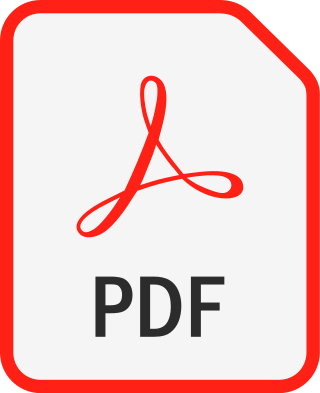
Portable Document Format (PDF), standardized as ISO 32000, is a file format developed by Adobe in 1992 to present documents, including text formatting and images, in a manner independent of application software, hardware, and operating systems. Based on the PostScript language, each PDF file encapsulates a complete description of a fixed-layout flat document, including the text, fonts, vector graphics, raster images and other information needed to display it. PDF has its roots in "The Camelot Project" initiated by Adobe co-founder John Warnock in 1991. PDF was standardized as ISO 32000 in 2008. The last edition as ISO 32000-2:2020 was published in December 2020.
The Organization for the Advancement of Structured Information Standards is a nonprofit consortium that works on the development, convergence, and adoption of projects - both open standards and open source - for Computer security, blockchain, Internet of things (IoT), emergency management, cloud computing, legal data exchange, energy, content technologies, and other areas.

In computing, configuration files are files used to configure the parameters and initial settings for some computer programs or applications, server processes and operating system settings.

Unified Extensible Firmware Interface is a specification that defines the architecture of the platform firmware used for booting the computer hardware and its interface for interaction with the operating system. Examples of firmware that implement the specification are AMI Aptio, Phoenix SecureCore, TianoCore EDK II, InsydeH2O. UEFI replaces the BIOS which was present in the boot ROM of all personal computers that are IBM PC compatible, although it can provide backwards compatibility with the BIOS using CSM booting. Intel developed the original Extensible Firmware Interface (EFI) specification. Some of the EFI's practices and data formats mirror those of Microsoft Windows. In 2005, UEFI deprecated EFI 1.10.
Extensibility is a software engineering and systems design principle that provides for future growth. Extensibility is a measure of the ability to extend a system and the level of effort required to implement the extension. Extensions can be through the addition of new functionality or through modification of existing functionality. The principle provides for enhancements without impairing existing system functions.
The Extensible Metadata Platform (XMP) is an ISO standard, originally created by Adobe Systems Inc., for the creation, processing and interchange of standardized and custom metadata for digital documents and data sets.
OpenBSM is an open source implementation of Sun's Basic Security Module (BSM) Audit API and file format. BSM, which is a system used for auditing, describes a set of system call and library interfaces for managing audit records as well as a token stream file format that permits extensible and generalized audit trail processing.

CD-Text is an extension of the Red Book Compact Disc specifications standard for audio CDs. It allows storage of additional information on a standards-compliant audio CD.
The Department of Defense Discovery Metadata Specification is a Net-Centric Enterprise Services (NCES) metadata initiative. DDMS is loosely based on the Dublin Core vocabulary. DDMS defines discovery metadata elements for resources posted to community and organizational shared spaces. It is sometimes (incorrectly) referred to as DoD Discovery Metadata Standard. The project focuses both on the process of developing a central taxonomy for metadata, and defining a way of discovering resources by their metadata using that taxonomy.
Open Vulnerability and Assessment Language (OVAL) is an international, information security, community standard to promote open and publicly available security content, and to standardize the transfer of this information across the entire spectrum of security tools and services. OVAL includes a language used to encode system details, and an assortment of content repositories held throughout the community. The language standardizes the three main steps of the assessment process:
- representing configuration information of systems for testing;
- analyzing the system for the presence of the specified machine state ; and
- reporting the results of this assessment.

The EFIsystem partition or ESP is a partition on a data storage device that is used by computers that have the Unified Extensible Firmware Interface (UEFI). When a computer is booted, UEFI firmware loads files stored on the ESP to start operating systems and various utilities.
The provider model is a design pattern formulated by Microsoft for use in the ASP.NET Starter Kits and formalized in .NET version 2.0. It is used to allow an application to choose from one of multiple implementations or "condiments" in the application configuration, for example, to provide access to different data stores to retrieve login information, or to use different storage methodologies such as a database, binary to disk, XML, etc.
Extensible Forms Description Language (XFDL) is a high-level computer language that facilitates defining a form as a single, stand-alone object using elements and attributes from the Extensible Markup Language (XML). Technically, it is a class of XML originally specified in a World Wide Web Consortium (W3C) Note. See Specifications below for links to the current versions of XFDL. XFDL It offers precise control over form layout, permitting replacement of existing business/government forms with electronic documents in a human-readable, open standard.
The Security Content Automation Protocol (SCAP) is a method for using specific standards to enable automated vulnerability management, measurement, and policy compliance evaluation of systems deployed in an organization, including e.g., FISMA compliance. The National Vulnerability Database (NVD) is the U.S. government content repository for SCAP. An example of an implementation of SCAP is OpenSCAP. SCAP is a suite of tools that have been compiled to be compatible with various protocols for things like configuration management, compliance requirements, software flaws, or vulnerabilities patching. Accumulation of these standards provides a means for data to be communicated between humans and machines efficiently. The objective of the framework is to promote a communal approach to the implementation of automated security mechanisms that are not monopolized.
Election Markup Language (EML) is an XML-based standard to support end to end management of election processes.
Caddy is an extensible, cross-platform, open-source web server written in Go.


